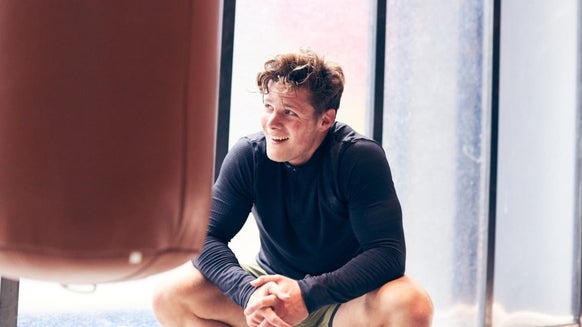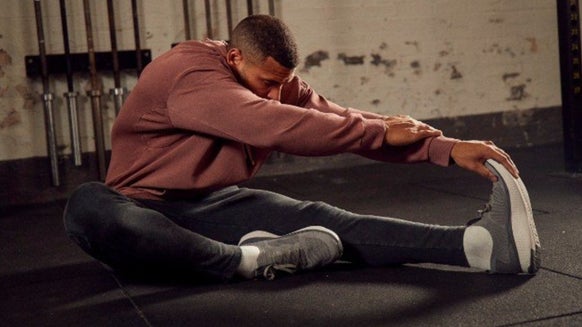50 Healthy Habits To Make Your Life Easier

What if there were simple and satisfying ways to make your life easier, without having to try too hard… you’d want to know about them, wouldn’t you? Well, you’re in luck.
Building small but intentional habits into your daily routine can support your wellbeing, make life more enjoyable, and keep you feeling energised and enthusiastic.
Let’s go through 50 of the top things you can do to make life just that little bit easier and happier.

Morning Habits
Set up for success with a well-placed alarm
Get that alarm set for the same time every morning and commit to getting up when it goes off. No snooze button.
Yes, it’s tough, but here’s the hack you didn’t know you needed... place your alarm on the other side of your room. You’ll force yourself up to turn off the racket, and since you’re up you can get the day started.
The 5,4,3,2,1 rule
This trick works at almost all moments during the day, not just in the morning. (However, it can be effective then too.)
When you need to do something or know it will benefit you but can’t quite get yourself to go, simply say “5,4,3,2,1” out loud.
On the “1”, you act. No time to overthink or procrastinate, only time to do.

Down it
A glass of water every morning before you eat or do anything else is a simple but beneficial habit for your mind and body.
It gets things moving and provides you with time to feel a little more alert. Plus, it adds to that all important daily water intake.
Create before you consume
Here’s a habit most of us are terrible at, yet it’s one that can provide so many important and insightful changes into our day.
Don’t consume any TV, radio, social media or emails, until you have “created” something.
Let your thoughts be the first ones you think or hear every morning, rather than going through your push notifications.
Spend time creating, whatever it is — a tasty breakfast, journalling, or just moving your body. Just make it about you.
Write down the first 3 hours of your week
While the first three hours are only a tiny part of the week, it’s arguably the most important. Putting your plan down into words can provide you with a sense of clarity, confidence and direction as you enter the week ahead.
This can have a domino effect, giving you the best chance of a productive week by setting off on the right foot.
Get into the nitty gritty. Start with that alarm going off, drinking the water, showering, etc. Tick it off — it always feels good when you’ve achieved things on a to-do list, no matter how small they seem.
A cold shower (or sea dip if you’re feeling extremely brave)
Even a few seconds of running the cold water before turning on the hot tap can bring about so many benefits at the start of the day.
Although it can take a while to get used to, the invigorating shock of cold water immediately wakes you, getting you ready for the day.
Why not start with just a few seconds each morning, build up your tolerance, and see if it has any benefits for you?
Make your bed
There are so many psychological benefits that can come from making your bed, including the pride of completing a task and making your room a more pleasant place to be. A few little jobs like this go a long way when performed regularly.
Get that SPF on before you go anywhere
You’ve got one face, so do what you can to protect it from the harm of the sun’s rays. The sooner you start this habit, the better.

Workouts, Activity & Movement
Set out your workout clothes the night before
Set up for success by having everything you need ready the night before.
Your gym outfit, water bottle, towel and trainers all ready to go.
This way there’s less chance of you “accidentally” running out of time to sort yourself out before gym class.
Park further away from the shop
It might seem more convenient to bag a car parking space right in front of the shop, but choosing a space a little further away is your new first choice.
This gives you a chance to get your NEAT levels up. NEAT stands for non-exercise activity thermogenesis, and is essentially the calories your body burns from small everyday tasks. The higher your NEAT levels, the more calories you burn.

Choose your top 3 workout songs
Have these 3 on standby for a day when you aren’t feeling up for your workout.
Instead of completely ditching your training, commit to exercising for the length of these three songs.
If you’re still not up for it after listening to your emergency tracks, you can head home. But if you’ve got yourself into the mood for more, result!
The “I don’t wanna workout” workout
Have one of these up your sleeve to pull out when you’re not in the mood to exercise.
It could be a combination of all your favourite movements within a circuit format, or it could be a relaxing stretching sequence.
Whatever it is, make sure it’s something you enjoy. It’s less about the calories you burn and more about exercising without hating every minute of it.

Prepare a spare gym kit
Whether you keep it in your car or at the office, prepare a spare bag with workout gear in.
We all have those forgetful days, but it doesn’t have to stop you from still getting your planned training session in. Oh, and don’t forget to put in some deodorant too...
Playlists
It’s no secret that music can make or break a training session. Having a few playlists created or saved to get you through those tough workouts is a major habit hack. Try to keep a variety up your sleeve.
A few “go-to” themes might be throwbacks, PBs, mobility, cardio, and weightlifting. Make it unique to your training needs. We’ve got a few set up already for you.

Running Playlist | Keep Up The Pace With The Perfect Playlist
Pump up the jam with the ultimate runner’s playlist.
Video your technique
It often feels a little awkward setting up your camera phone in the gym, but recording your technique or performance while training can provide so many benefits.
Being able to see your body move will help you figure out areas that need improvement or areas where the training could be intensified.
Body awareness mid-workout can be difficult (particularly for beginners), so help yourself out and record what you are doing.
But please be respectful of others in the gym. Make sure you are recording only yourself and not taking up any extra space or equipment to film.
Use the stairs
This one’s simple. Get those legs climbing and choose the stairs over the lift or escalator. A little extra movement here and there really adds up. Just do it. It’s NEAT.
Get active outside the gym
Finding time during your week to do something active and enjoyable that doesn’t involve lifting barbells or spinning on a bike can be an important step.
Learning to enjoy movement in other ways can make the process of getting fitter much more tangible and inclusive of life’s daily routine.
Why not make it a habit to do one non-gym related activity once a month?

Dry shampoo is a necessity
Long-haired friends, we may not like to admit it but often our workout routine is based solely on when we have to wash our hair. The last thing you want to do after pampering yourself is to get a sweat on.
But let’s cut the excuses… buy yourself some dry shampoo and keep it stashed in your bag. Less need for a full hair-wash, more time for focusing on those health and fitness goals.
Nutrition
Set out your vitamins
Somehow, remembering to take your vitamins and supplements seems much harder than remembering to make that morning coffee.
So, why not “habit stack” and place your supplements beside your non-negotiable habit.
The chances of remembering to take those healthy extras skyrocket immediately when you can see them in front of you as you reach for your toothbrush or coffee cup.
Grab yourself some Myprotein FlavDrops
Adding these absolute game changers into your food when you’re trying to save some calories will make your life much easier.
Putting a few drops of these tasty flavours into your yoghurt, porridge, coffee and on baked goods will completely transform the taste, but with no extra calories.
“Step it up” with your alarm
Desk jobs can make it much more difficult to get your body moving. We know getting up and generating some sort of movement is so good for the body and mind, yet we often don’t make much effort to get active.
Setting an alarm as your gentle reminder to get up and move (for even one minute) can help prompt small changes.
Maybe you use this alarm to walk up the stairs or walk to the kitchen to fill up your water bottle. You choose what the alarm signifies, but make it about movement.
Plan out and punch in your meals the night before
Just like planning your day out, planning your meals out can also make it much easier for you to stay on track.
Scanning in meals or manually entering your food into a tracking app the night before means there’s no need for you to try and frantically work out your calories or macros during a hectic day.
If you’ve ever tried to start calculating at 4pm to see if you have enough calories left over for dinner, you’ll know it’s not a fun experience.
While tracking isn’t for everyone, if you’re on this journey, make it a little easier for yourself and try the planning-ahead approach.
Bulk buy
Again, planning ahead comes into it here.
If you’ve a plan of what you need, try to bulk buy your favourites or staples.
It saves money long-term and makes you more accountable for your eating and drinking habits.
Human beings naturally gravitate towards routine when we find things that work for us... so if you find a specific food or drink you like, bulk buy it — you’d have been buying it again anyway.
Meal prep and freeze
The same concept applies to actually cooking your purchased items. Batch cook your meals and freeze them.
Chillis, stews and soups are always going to be good choices. Pull the meals out of the freezer that morning and enjoy for dinner.
No stress, no fuss, no time wasted.

57 Meal Prep Recipes For Muscle Building & Fat Loss
Your next favourite prep is in here...
Utilise protein powder
Adding protein powder into your daily routine is one of the easiest and most convenient ways to hit your protein goal.
With a huge array of Myprotein flavours, there’s something for everyone. And get creative with how you have it... put it in shakes, smoothies or baked treats.
Aim for 1 protein source in every meal
A great way to keep you fuller for longer and ensure you’re aiding the growth and repair of your body is to get in the habit of adding one protein source into each meal.
This might be eggs, chicken, Greek yoghurt, protein powder, etc. These choices mean you’re less likely to reach for sugary, high-calorie snacks that only leave you feeling hungry after 10 minutes.
Volume eat
When you’re trying to lose a few pounds it often means feeling a little more hungry than usual (particularly if you don’t choose nutrient dense and satiating foods).
In order to combat these hunger feelings as much as possible, increasing the volume of your meals by adding in additional vegetables or lower-calorie foods can make this process feel more doable.
Why not bulk up your lunches with salads and dinners with steamed or roasted vegetables?
Compare your sauces before buying
There are lower-fat, lower-sugar, and lower-calorie options everywhere. All it takes is a few extra seconds in the supermarket to compare one or two of the options in front of you.
It’s an easy way to work on your nutritional choices without having to think too hard.
Choose the “zero-calorie” fizzy drinks instead
Those hidden liquid calories all add up. Often there’s very little difference in taste between full sugar and low sugar... yet the difference it has on your energy intake can be significant.
Save the unnecessary sugar highs and choose more wisely.
Keep healthy snacks on hand
The glove compartment in your car, the front pocket of your rucksack, the drawer in your office desk... all perfect places for storing snacks.
Having a stash of healthy alternatives at the ready can save you a few quid but also keep you on track when life gets a little hectic and your schedule becomes unexpected.
This way your snacks can leave you feeling satisfied without going off plan.
Buy portioned controlled items rather than “share bags”
While it might feel like value for money, and we did say bulk buy earlier, share bags can lead your macros astray. Pre-portioned foods can make it easier to prevent over-indulging.
Consider what’s going to be most beneficial to you with your current goals in mind.
Don’t buy what you don’t want to eat
We all do it. We buy treats and tell ourselves we’ll just keep them in the cupboard but only eat one as a treat. Next thing, we’ve eaten the entire contents.
Often when we see something enticing, we can’t help but eat it. If you struggle with this, the best way to prevent this is to just not buy it in the first place. Then, it won’t be so difficult to resist later on.
Chew your food
You heard it when you were younger and for good reason. Not chewing your food properly is often the reason for indigestion or feeling bloated after eating.
Additionally, the faster we eat, the more likely we are to overeat. Our brains and bodies need time to register that we have eaten, we continue to eat even when we may be full.
Before going for a second helping, wait 10 minutes to see if you feel full. After this time, you may have changed your mind.
Mindful Moments
End of week/day check-in
Checking in on yourself is just as important as checking in on a loved one. Ask yourself how your day or week was and follow it with a couple more questions…
“What did I need more of and what did I need less of?”
These will provide you with an indication as to where you need to place more or less of your energy moving forward.
10 breaths a day
Taking a moment to breathe (properly) during your day should be a priority if you want to feel calmer and more coherent.
Place your hands on your belly, close your eyes and just notice the rise and fall of your abdomen as you inhale through your nose and exhale through your mouth.
This may be best done in your bed as you wake up or before you go to sleep.
3 minutes of gratitude
Taking three moments throughout the day or at night to consider what you are grateful can do a lot to support your wellbeing.
Either writing these small moments of gratitude down or speaking them aloud has the power to change your perspective on your day.
“What you focus on grows”. The more you practice seeing good things, the more you’ll actually notice.
Lunchtime fresh air
Your lunch break can be the perfect time to breathe, reset and refocus. It’s hard to do this when you don’t move from the environment you’re working in.
Get up, get out and breathe in the fresh air – even if it is only for a few minutes. Change your scenery and reawaken your senses.

30 seconds of mindfulness
Here’s a simple pause exercise to try each day.
Five things you can see, four things you can hear, three things you can touch, two things you can smell, and one thing you can taste.
No distractions, just you and your senses. It’s a wonderful calming technique that also brings about a new appreciation for your surroundings.
Get comfortable alone
When you want to do something but have no one else to do it with, do it yourself.
Take yourself on lunch dates, go to the cinema or a concert. Notice the discomfort and embrace it. Learn to love yourself and understand yourself enough to appreciate your own company.
Look up
Without realising, we can spend much of the day looking down or straight in front of us. So pause and look up once in a while.
It’s a lovely reminder that there’s a big world around you. Look up, see the brightness, and breathe.
Connect
Every day make an effort to strike up a conversation with one person as you move through your to-do list.
Engage in the conversation fully and smile. Watch how your mood shifts when you place your energy on the conversation at hand and not on what else you need to do that day.
Digital motivation
If you have a goal in mind or an image that represents something you are trying to achieve, set your phone or laptop background up with a reminder of it.
Visually seeing your desired outcome can help keep you committed to your actions.
Stop scrolling
Prevent yourself from mindless excessive scrolling and put down your phone, especially in bed. Not having access to your phone while in bed will make calming down, switching off and sleeping much easier.
Get yourself a proper alarm and either turn your phone off or put it in another room. After a while you’ll begin to feel better about relying on it less.
Record your progress
No matter your goal, documenting progress is one way to keep you motivated and provide you with important evidence and reassurance that you are moving in the right direction.
Keep a notebook for your “wins” and write down all the triumphs, no matter how small they might seem.
5-minute tidy-up
Similar to making the bed, every night before you go to sleep choose one room in your living space to briefly tidy.
It doesn’t have to be an intensive process, but just a quick, simple declutter.
Choose a different room each night of the week. This means by the weekend when the big clean is no way near as daunting. Give future you a head start.
Compliment someone
Simply tell someone how great they are or how much you like a quality they have shown.
Be kind and watch how it not only makes them feel good but also boosts your own mood.
Set one weekly goal
A great way to make your week more successful is to choose one main task to focus on each week.
There’s no need to become overwhelmed with 25 goals — that’s one way to make life extra stressful.
Simply choose one non-negotiable goal for the week and place your energy on it.
Sunday night is a great time to reflect on the previous week and decide where you want your emphasis to be. Maybe it’s water intake? Maybe it’s protein intake? Make it something you see a need for.

Buy a plant and look after it
There’s a purpose to be found in having plants to take care of.
Looking after something else is also a way to look after ourselves. Use it as your reminder that attention and care doesn’t have to take a lot of effort, but it can make something grow into something beautiful.
Sort the kitchen cupboards
Taking a little time to organise your cupboard space can be a game changer. It allows you to see exactly what you have and how you can best make use of your ingredients.
If you’re feeling super invested in this idea, labelling jars and tupperware can be extremely beneficial, showing you exactly how much you have of each ingredient.
Let yourself rest
The “rise and grind” mentality allows little time for rest.
So intentionally build it into your schedule.
Whether this means a rest day from the gym or one hour each week where you set aside time to do nothing specific but relax. If you don’t build this habit into your routine, it becomes easy for it to get missed.
Take home message
While fifty habits might seem like a lot of work, choosing a few to implement into your routine isn’t all that difficult. Once they’re established, you can add in another few, and then some more after that.
Over time these small and simple steps become significant in helping you move further towards your health and fitness goals while making your life that little bit easier.
FIND MORE HERE:

Dopamine Menus: How to Be Happy and Dopamenu Examples
A to-do list that brings you joy.



















